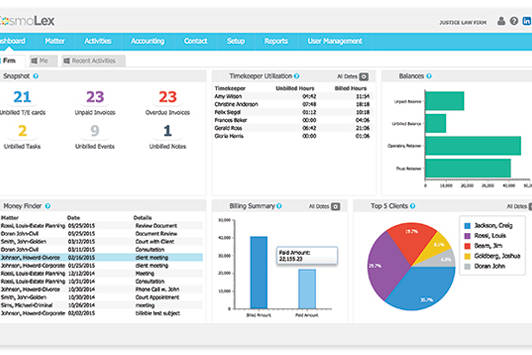Direct Mail for Lawyers: The Power of the Postbox

This is especially true for lawyers and law firms, where building trust, credibility, and local reputation can be paramount to success.
Direct mail, despite its ‘old school’ label, continues to prove itself as an effective tool to reach prospective clients, communicate complex messages, and cultivate lasting relationships.
Whether you’re a seasoned attorney looking to expand your client base or a young legal eagle setting your sights on your first clients, understanding the role of direct mail in your marketing strategy could just be the key to unlocking your next level of growth.
By the end of this article, you’ll have answers to questions like:
- Is Direct Mail still relevant?
- What are the advantages of Direct Mail?
- What does effective Direct Mail look like?
- What are best practices for design and presentation?
- How does Direct Mail work with digital marketing?
- and more!
Direct mail for lawyers is a traditional, yet powerful marketing tool that delivers targeted messages directly to potential clients, fostering trust, enhancing local reputation, and driving growth for law firms.
Understanding the Role of Direct Mail in Legal Marketing
While it’s undeniable that digital channels have revolutionized how we market and communicate, the relevance and impact of direct mail in the legal sector should not be underestimated.
Unlike the fleeting nature of digital content, physical mail is tactile, tangible, and can create a lasting impression that resonates with potential clients.
Direct mail should not be seen as an outdated practice, but rather as an integral component of a comprehensive legal marketing strategy. It complements digital marketing efforts and provides a unique, more personal way to reach and engage potential clients.
By leveraging the strengths of direct mail, law firms can diversify their marketing efforts, foster stronger connections, and ultimately drive business growth.
Create a
Successful Law Firm Marketing Strategy
In 10 minutes or less!
Our template will help you to:
- Define your SMART goals
- Craft your brand story
- Create your customer personas
- …and more!
Why Direct Mail is Still Relevant for Lawyers
Direct mail continues to retain its relevance for lawyers and law firms amidst the digital revolution for several reasons.
The digital marketing landscape is highly competitive with countless advertisements vying for attention. Amidst this saturated digital landscape, direct mail allows a law firm’s message to cut through the noise, standing out from the sea of digital communications.
This is especially valuable when you consider that the mailbox often presents a less cluttered environment than a typical email inbox.
Likelihood of Reading Direct Mail/Email
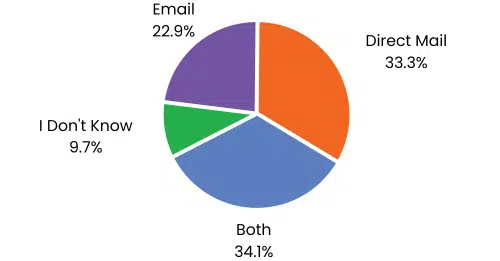
Direct mail holds an inherent advantage when it comes to personalization and building a sense of connection. The tactile experience of receiving and opening a physical mail can create a lasting impression that is difficult to replicate digitally.
This level of personal touch helps to foster a sense of trust and connection between the law firm and the recipient.
Another crucial point to consider is that while digital media consumption is indeed widespread, it’s not all-encompassing. There are demographic groups that aren’t as digitally inclined or simply prefer traditional means of communication.
Direct mail ensures that law firms can reach potential clients across all segments of the population, irrespective of their digital savviness.
As you see below, ages 65+ are much more interested in checking their mail.
Eagerness to Check Mail by Age Group
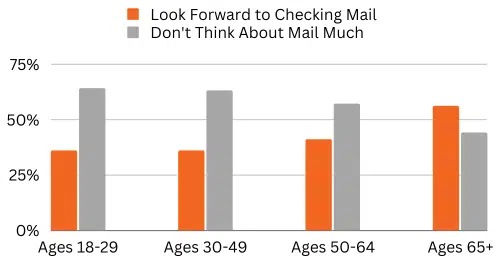
Moreover, direct mail also often enjoys a perception of trustworthiness and authenticity. In an era where digital scams are increasingly prevalent, physical mail can be seen as more legitimate and reliable.
This is particularly critical in the legal industry, where trust forms the foundation of client relationships.
Lastly, direct mail plays a vital role as a supplement to digital marketing strategies. A cohesive, multi-touch marketing approach that incorporates both digital and physical touchpoints can significantly enhance brand recognition and deepen the impact of a law firm’s message.
Research also suggests that direct mail engages more of the brain’s cognitive functions, resulting in better memory and recall compared to digital media.
Motivation-to-Cognitive Load Ratio by Media Format
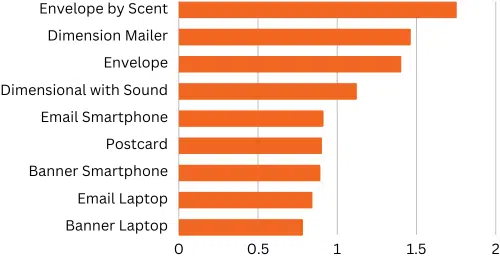
Direct mail’s unique blend of personal touch, accessibility, authenticity, and its potential for a synergistic relationship with digital strategies ensures its ongoing relevance in the legal marketing toolkit.
Benefits of Direct Mail Marketing for Law Firms
Despite the rise of digital marketing, direct mail remains a potent tool in the marketing arsenal of lawyers and law firms, and here’s why:
-
Trustworthiness
In an age of rampant digital fraud and scams, a physical piece of mail can seem more legitimate and trustworthy to some recipients. This perception of authenticity can be especially valuable in the legal industry, where trust is crucial.
-
Personal Touch
Direct mail adds a personal touch that electronic communication often lacks. A well-crafted mail piece, addressed directly to the recipient, can leave a lasting impression and foster a sense of connection.

-
Accessibility
While digital adoption is high, not all demographics are digitally savvy or prefer digital communication. Direct mail ensures that you can reach potential clients across all age groups and technological preferences.
-
Market Saturation
The digital space is saturated with advertisements, making it increasingly difficult to grab attention. Direct mail, conversely, faces less competition, allowing your message to stand out.
What is Done with Mail when Received
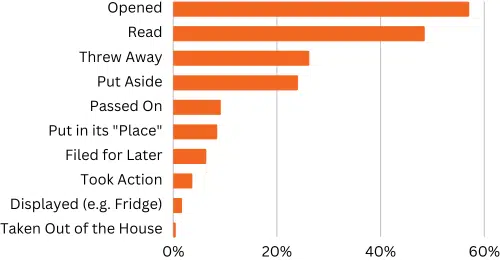
-
Complement to Digital Strategies
Direct mail is an excellent complement to digital strategies, providing a multi-touch marketing approach. A coordinated campaign that includes both digital and physical touchpoints can enhance brand recognition and message recall.
-
Greater Engagement
Studies suggest that direct mail tends to engage more of the brain’s cognitive functions, leading to higher rates of memory and recall compared to digital media.
Related – Law Firm Marketing Strategy: Use this guide to help craft the perfect marketing strategy for your law firm.
Legal Ethics to Consider in Direct Mail Marketing
Legal marketing, including direct mail, doesn’t exist in a vacuum. It must adhere to the ethical rules that govern the profession. To maintain our ethical integrity, we ought to consider the following principles:
1
Truthfulness and Accuracy
All information that lawyers share through their marketing efforts must be verifiable and accurate. This includes claims about a firm’s successes, the expertise of the lawyers, or the benefits of the services offered.
Misleading or unsubstantiated claims can be detrimental to the public’s perception of the legal profession, potentially leading to disciplinary actions from the legal authority.

2
Privacy and Confidentiality
Every lawyer has a duty to respect and protect the confidentiality of information obtained in their professional relationships. In direct mail marketing, this implies the necessity of using mailing lists obtained in compliance with all relevant privacy laws.
It also means not disclosing any confidential information acquired from professional dealings, unless explicit consent has been given.

3
Solicitation Rules
Solicitation involves direct outreach to potential clients with the intention of procuring business. Rules governing solicitation can vary widely between jurisdictions. Typically, such rules dictate the manner, timing, and recipients of the solicitation, requiring the clear labeling of such communications as advertisements, for instance.

4
Proper Identification
To maintain transparency and trust, lawyers must identify themselves accurately in their marketing materials. This includes providing the name and address of the law firm responsible for the direct mail’s content.
Additionally, marketing materials must also clarify that they are promotional in nature.

5
Respectful Content
The legal profession carries with it the obligation of maintaining decorum and respectability. As such, sensational or overly self-praising language in direct mail could harm the profession’s reputation. The content should be professional, respectful, and avoid claims that may be viewed as disrespectful or boastful.

Remember, these principles are based on maintaining the integrity of the legal profession and the trust that the public places in it.
It’s always recommended that lawyers familiarize themselves with their jurisdiction’s specific rules and seek counsel if unsure about their marketing’s ethical compliance.
Key Elements of Successful Direct Mail Campaigns for Lawyers
-
Personalization
Personalized mail feels more exclusive and garners more attention. Use your recipient’s name, refer to their specific situation if possible, and ensure the content is highly relevant to their needs.
-
Understanding Your Audience
A successful campaign starts with identifying your target demographic. Knowing your potential clients’ needs, preferences, and values can help craft a message that resonates with them. This could be based on factors like geographic location, age, income level, or the specific legal services they might need. Take a look at this example that addresses concerns with a visually-appealing aid.
Image Credit: Caroline Henson
-
Clear, Compelling Message
Your message should be concise, easy to understand, and compelling. It should immediately convey the value of your services and how you can help the recipient. Remember, legal jargon can be off-putting to many, so keep the language simple and accessible.
-
Professional Design
The design of your mailer reflects your law firm’s brand and professionalism. It should be clean, uncluttered, and appealing. If possible, hire a professional designer to ensure your mailer is visually attractive and aligned with your firm’s branding.
Image credit: Warren Hardy
-
Strong Call to Action (CTA)
Every piece of direct mail should have a clear and compelling call to action. Whether it’s to call for a free consultation, visit your website, or download a helpful legal guide, make sure the recipient knows what step to take next.
-
Tracking and Evaluation
Use unique URLs, QR codes, or phone numbers to track responses to your campaign. Evaluate the effectiveness of your campaign by analyzing response rates, conversions, and return on investment. This data will be invaluable for refining your future direct mail efforts.
Image Credit: Imperfect Foods
-
Ethical Compliance
As discussed earlier, all direct mail campaigns must comply with the ethical rules governing lawyer advertising. This includes being truthful and transparent, respecting privacy, and avoiding any form of coercion.
-
Follow-Up Mechanism
Have a system in place to follow up with those who respond to your mail. This could be a dedicated phone line, an online booking system for consultations, or a prompt email response system.
By considering these key elements, lawyers can design direct mail campaigns that not only reach their intended audience but also inspire action, building a stronger connection between potential clients and the law firm.
Strategies for Integrating Direct Mail with Digital Marketing
The integration of direct mail and digital marketing creates a potent combination that leverages the strengths of both mediums. It enables the creation of a multi-touch marketing campaign, expanding reach and reinforcing the message across multiple platforms.
Here are some effective strategies for marrying these two approaches:
Strategy 1: Consistent Branding
Ensure your brand’s aesthetic and messaging is consistent across both direct mail and digital channels. This helps increase brand recognition and lends credibility to your marketing efforts.
Strategy 2: QR Codes and Personalized URLs (PURLs)
Including QR codes or PURLs in your direct mail pieces can help bridge the gap between physical and digital. Recipients can scan the QR code or visit the PURL to learn more, fill out a form, or even schedule a consultation, thereby immediately engaging with your digital presence.

Strategy 3: Retargeting Campaigns
Use direct mail to complement your digital retargeting campaigns. If a potential client visits your website but doesn’t take action, you can send them a personalized direct mail piece to re-engage them.
Strategy 4: Email Follow-Ups
If you have permission to contact the recipient via email, a well-timed email follow-up after the direct mail piece has been delivered can reinforce your message and encourage digital engagement.
Strategy 5: Social Media Integration
Announce your direct mail campaign on social media or encourage recipients to join your social media community. For instance, you could include an invitation to enter a giveaway on your Facebook page or to join a webinar on LinkedIn.
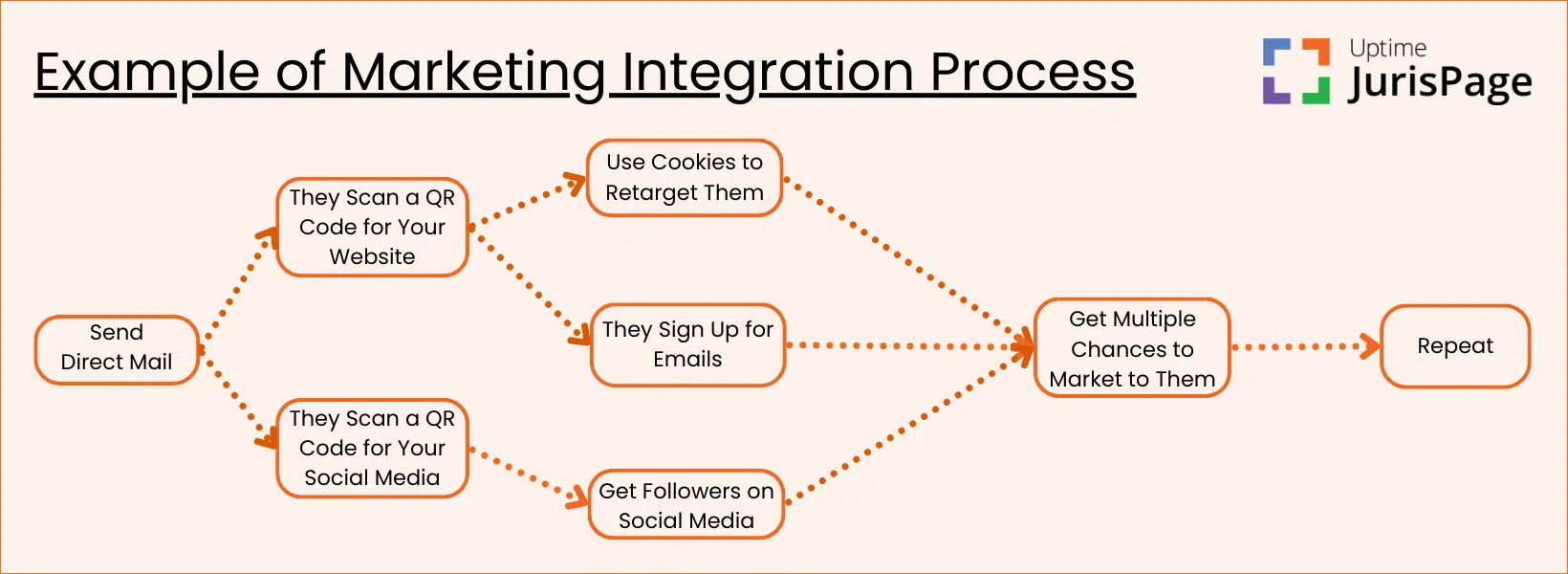
Strategy 6: Data Synchronization
Leverage the data from your direct mail campaign to enrich your digital marketing strategy and vice versa. The demographic insights gained from one can be applied to the other to fine-tune targeting and personalization.
Strategy 7: Multi-Channel Analytics
Use analytics to understand the customer journey across both physical and digital touchpoints. This will provide a more holistic view of your marketing effectiveness and help you adjust your strategies for better results.
I’ll discuss this more shortly, but here is an example of tracking multiple marketing channels.
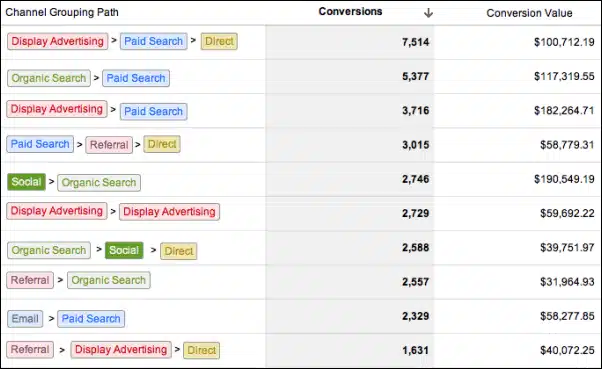
By thoughtfully integrating direct mail with digital marketing, you can create a cohesive, cross-channel campaign that engages your audience on multiple fronts, amplifies your message, and optimizes conversion rates.
The key is to ensure that each element supports and reinforces the other, providing multiple opportunities for potential clients to engage with your law firm.
5 DOs and DON’Ts for Measuring Direct Mail Success
Measuring the success of your direct mail campaign is vital for understanding its effectiveness and informing future strategy. Below are some best practices to follow, along with pitfalls to avoid:
- DO: Provide Value
Consider including some educational material and/or an offer that will help your audience perceive value. This often translates to better trust between you and them, along with better engagement and conversions.
- DON’T: Only Focus on Your Needs
If you don’t take the time to understand what your audience really needs or wants, you won’t understand how you can provide a service to them. I recommend finding pain points and providing solutions.
- DO: Pay Attention to All Analytics
The response rate is the number of people who responded to your mail piece divided by the number of mail pieces sent. A higher response rate generally indicates a more effective campaign. Along with this, ensure that you are attracting, engaging, and converting high quality leads with each campaign.
- DON’T: Focus Solely on Response Rate
Ignoring the quality of those responses will give you a skewed understanding of the true success of your campaigns. Receiving a large number of responses from uninterested or unqualified individuals does not contribute to your ultimate goal.
- DO: Value Cost per Acquisition
This metric measures how much it costs you to acquire a new client through the campaign. Valuing the attributed costs can give you clear understanding for which strategies or campaigns are going to give you the best return for your time and money.
- DON’T: Cut Corners to be Cost-Effective
While it’s important to strive for a low cost per acquisition, avoid the trap of cutting corners to lower costs. Sacrificing the quality of your direct mail pieces could damage your brand image and deter potential clients. Find ways to cut cost that don’t hinder progress you’ve made or tarnish relationships you’ve developed.
- DO: Establish Testing and Control Groups
Try sending out different versions of your direct mail (varying design, message, offer, etc.) to see which one performs better, while sending a single version to a control group. This can provide valuable insights for improving future campaigns.
- DON’T: Create Unparallel Testing/Control Groups
Be careful to ensure your control and test groups are comparable in demographics and behavior to make your comparison valid. When you’re testing varying campaigns, it’s important to isolate a single variable to have the clearest insight, as opposed to having too many variables to where you struggle to find proper causation.
- DO: Use Unique Codes or URLs
Incorporate unique codes or URLs to track how many people are responding to your direct mail and taking action online. Having this metric will not only give your audience actionable steps to take but also gives you a way to track results from different campaigns.
- DON’T: Use Generic Codes or URLs Avoid using generic URLs or codes as they won’t allow you to track the direct impact of your mail campaign. Having a unique code/URL for each campaign gives you more precise data.
Remember, measuring a campaign’s success is not a one-size-fits-all process.
The metrics that matter most will depend on your campaign’s specific goals and the needs of your law firm. However, by combining these practices, you can gain a comprehensive understanding of how your direct mail campaigns are performing and how to improve them.
By correctly implementing and interpreting these measurements, you can gain valuable insights into your direct mail campaign’s effectiveness and use that information to make data-driven decisions for future marketing strategies.
Related – How to Grow a Law Firm: Growing a law firm can be difficult, but it doesn’t have to be. Read this article to learn how.
Making Direct Mail Work for Your Law Firm
Direct mail may seem like an outdated approach to marketing, but it offers a personal, targeted, and tangible touchpoint that, when used thoughtfully and ethically, can help lawyers connect with potential clients in a meaningful way.
The integration of direct mail with digital marketing strategies can further amplify the reach and effectiveness of your campaigns, creating a multi-faceted approach that engages your audience across various platforms.
It’s about marrying the tactile, personal nature of direct mail with the instant, wide-reaching capabilities of digital media.

Whether it’s in the form of a beautifully designed postcard or a highly targeted email, the end goal is the same: to communicate your value proposition to potential clients and encourage them to engage with your services.
Successful direct mail campaigns involve careful planning, tracking, and measuring. By identifying clear objectives, implementing unique trackers, and continuously analyzing the results, law firms can maximize the potential of their campaigns.

Finally, it’s essential to remember the ethical considerations tied to direct mail marketing for lawyers. Respect for privacy, truthfulness, and professional integrity should always be at the forefront of any legal marketing strategy.
The use of direct mail by lawyers is not just about getting your name out there; it’s about building relationships, fostering trust, and demonstrating how your services can help people in need.
So, dust off that stationary, and start exploring how direct mail could complement your law firm’s marketing strategy.
Want to do more than just "get by"?
Attract (and convert) qualified sales leads with Legal Marketing 360, our all-in-one law firm marketing package that includes an expertly crafted Google Ad campaign, SEO program, and website design.
Frequently Asked Questions About Direct Mail for Lawyers
Despite the rise of digital marketing, direct mail remains relevant due to its tangible nature, high engagement rates, and ability to reach audiences who may not be as digitally active.
Direct mail can cut through the digital noise and offer a personal touch that digital marketing often lacks.
Direct mail marketing involves sending promotional materials, such as postcards, brochures, or letters, directly to potential clients’ mailboxes.
It can benefit lawyers by reaching a targeted audience, creating a tangible touchpoint, bypassing crowded digital spaces, and achieving high engagement rates.
Direct mail can drive recipients to a law firm’s online platforms, such as websites or social media pages. Additionally, combining direct mail with digital efforts, such as retargeting campaigns or email follow-ups, can increase overall engagement and conversion rates.
Key elements include understanding your target audience, personalizing your materials, having a clear and compelling message, professional design, strong call-to-action, ethical compliance, and a follow-up mechanism.
Lawyers need to consider truthfulness and accuracy, privacy and confidentiality, solicitation rules, proper identification, respectful content, offering a service, and avoiding coercion or duress in their direct mail campaigns.
Lawyers can measure the success of their campaigns through several methods, including tracking response rates, using unique trackers like QR codes or PURLs, calculating return on investment (ROI), utilizing redemption codes for special offers, and gathering feedback from recipients.
Strategies include consistent branding across all channels, using QR codes and PURLs in direct mail, launching retargeting campaigns, sending email follow-ups, integrating social media, synchronizing data between platforms, and using multi-channel analytics.
Dennis Dimka
As the founder and CEO of Uptime Legal Systems, I've had the privilege of guiding our company to become a leading provider of technology services for law firms.
Our growth, both organic and through strategic acquisitions, has enabled us to offer a diverse range of services, tailored to the evolving needs of the legal industry.
Being recognized as an Ernst & Young Entrepreneur of the Year Finalist and seeing Uptime Legal ranked among the Inc. 5000 list of fastest-growing private companies in America for eight consecutive years are testaments to our team's dedication.
At Uptime Legal, we strive to continuously innovate and adapt in the rapidly evolving legal tech landscape, ensuring that law firms have access to the most advanced and reliable technology solutions.
Related Posts
March 8, 2024
Keyword Research for Lawyers: Choosing the Right Keywords to Get More Traffic and Leads
The ultimate guide to keyword research…
December 20, 2023
SEO Myths and Misconceptions in Legal Marketing
Master SEO for law firms. Learn what…
December 19, 2023
Creating Effective Local Landing Pages for Law Firms
Master local landing pages for law…
December 14, 2023
Reputation Management for Lawyers: The Ultimate Guide
Master reputation management for…
November 22, 2023
Law Firm Marketing: A Complete Guide (with 24 Strategies)
Here's everything you need to know to…
June 28, 2023
How to Grow a Law Firm: Essential Strategies for Success
Uncover essential steps on how to grow…
June 14, 2023
Radio Advertising for Lawyers: What You Need to Know
Learn everything you need to know about…
May 15, 2023
Email Marketing for Law Firms: How to Attract & Retain More Clients with Email
Learn everything you need to know to…
May 3, 2023
Law Firm Branding: How to Build a Strong Brand (With Examples)
Learn how to build a strong brand that…
May 1, 2023
Remarketing Ads for Lawyers: How to Stay Top-of-Mind and Drive Conversions
Learn all about remarketing ads for…
April 20, 2023
Mastering Online Marketing: A Comprehensive Guide for Lawyers
Learn all about online marketing for…
April 4, 2023
Criminal Defense Law Firm Website Statistics (100 Firms Analyzed)
We analyzed the top 100 criminal…
March 17, 2023
How to Improve Your Law Firm’s Online Presence
Learn everything you need to know about…
February 10, 2023
How to Get More Google Reviews for Your Law Firm
Get more Google reviews for your law…
February 9, 2023
Google Business Profile Optimization for Lawyers: A Guide
Google Business Profile Optimization…
January 31, 2023
Law Firm Marketing Plan: A Step-By-Step Template [Free PDF]
Download a free law firm marketing plan…
January 10, 2023
Live Chat for Law Firms: The Best 15 Live Chat Apps for Attorney Websites
In this article, we review the best 15…
January 4, 2023
Legal Directories: Best Lawyer Directories in 2023
Learn all about legal directories,…
December 6, 2022
Attorney Bio Pages: 13 Ways to Supercharge Your Profile
Learn about the importance of attorney…
November 28, 2022
Lawyer Statistics: 55 Eye-Opening Stats & Trends for 2023
Find out everything you could ever want…
September 7, 2022
[Video] 3 Ways to Get More Law Clients: Show Authority, Credibility & Capability
3 ways to get more law clients by…
August 29, 2022
How to Get More Clients for Your Law Firm: A Guide
Looking to start bringing in more leads…
August 4, 2022
Link Building for Lawyers: 13 Strategies to Build Your Link Profile
Learn about the importance of link…
June 1, 2022
Law Firm Marketing Budget: How Much Should You Spend on Marketing in 2023?
Wondering how much it costs to market…
May 5, 2022
Lead Generation for Lawyers: How to Generate More Leads
Learn why lead generation for lawyers…
April 4, 2022
CosmoLex Review: A Lawyer’s Case Management Test Drive
A comprehensive Cosmolex review for…
April 4, 2022
What Does Your Font Say About Your Firm? The Best Law Firm Logo Fonts
Fonts go a long way in communicating…
February 11, 2022
Lawyer Awards: Top National, International, and Local Awards to Apply For
To establish credibility for your law…
January 4, 2022
Avvo Lawyer Marketing Guide: 17 Avvo Marketing Techniques & Tactics
A guide to marketing yourself and your…
December 1, 2021
The Pros and Cons of .lawyer and .law Domain Names
Should you have a .lawyer or .law…






































